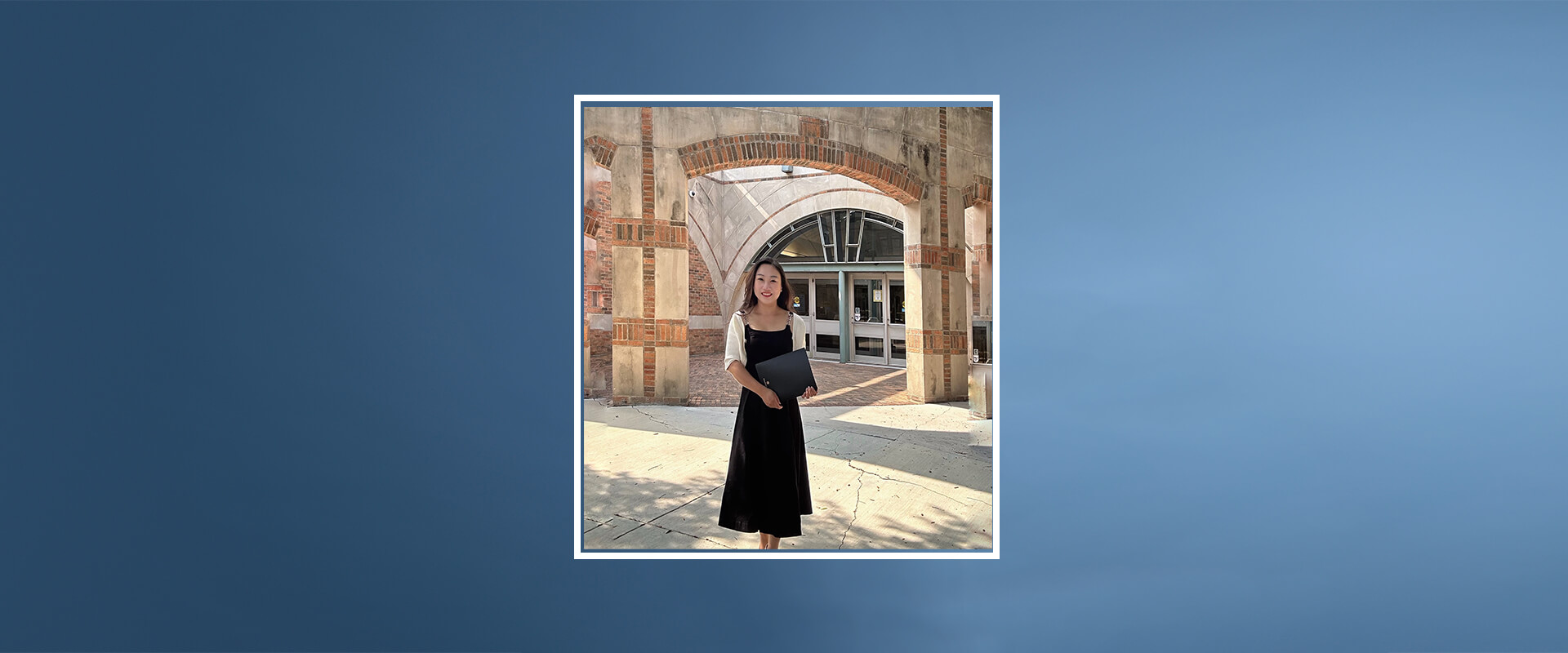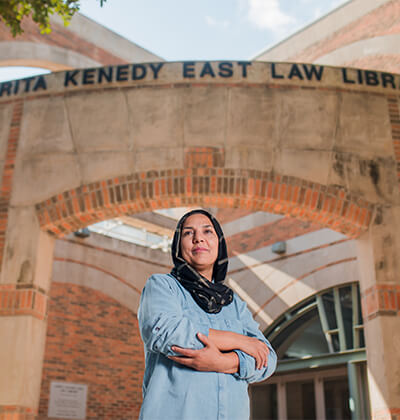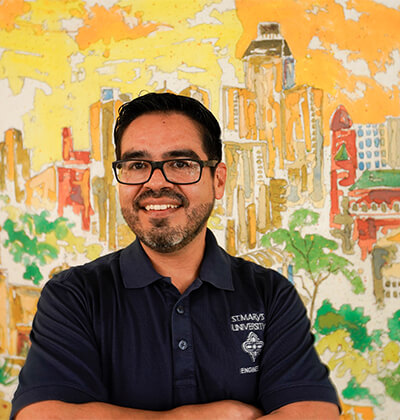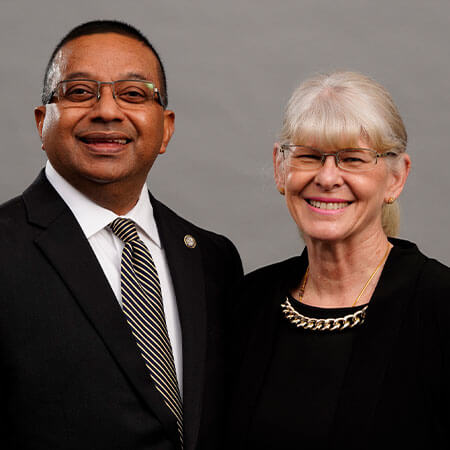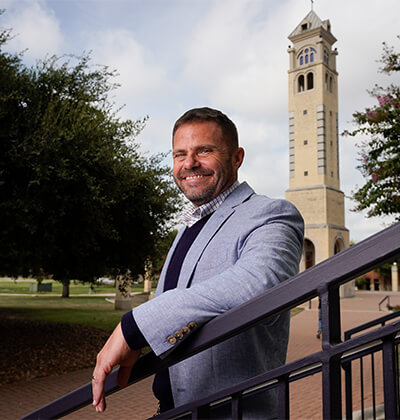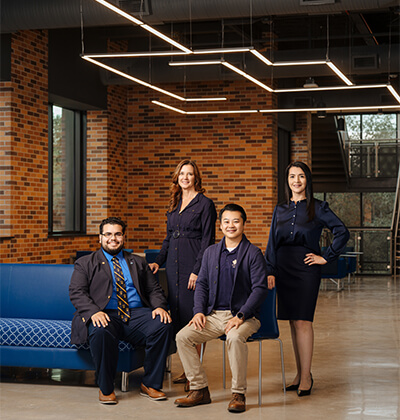Research approach, teaching perspective changed by experience at St. Mary’s Law
by Du Ying
As the Spring 2024 semester was ending, Du Ying, a student from China who is in the LL.M. Program at the St. Mary’s University School of Law, sat down with Yun Weixiao, Visiting Scholar at St. Mary’s University School of Law and Law Professor at Changchun Humanities Academy in China, to learn about her experience as a Visiting Scholar on campus.
As part of a one-year academic exchange through St. Mary’s Visiting Scholar Program, Weixiao explains the welcoming and inclusive environment, access to research resources, and lessons learned that will alert her future research work and teaching style.
Q: Could you please briefly introduce yourself?
A: I am from the School of Law at Changchun Humanities Academy (formerly the School of Humanities at Northeast Normal University) in China. I am a full-time teacher with research interests in the history of Western law and issues related to economic law, and have been teaching for nine years. Currently, I am a Visiting Scholar at the St. Mary’s University School of Law in the United States, where I am conducting a one-year academic exchange. I spent two years studying in the U.K. during my university years, and the exchanges and learning experiences between different countries have brought me many unique insights.
Q: With your impressive background — not only studying abroad, but also earning your master’s and Ph.D. from two top law schools in China — I’m sure you had your pick of places for a visiting scholarship. What made you choose the St. Mary’s University School of Law as your destination?

A: This is certainly the result of a serious decision, and it is also a mutual commitment process. Firstly, through internet resources and the experiences of previous Visiting Scholars, I learned that this is a university with a long history, located in a city, San Antonio, Texas, which also has a rich cultural heritage. The city’s safety is commendably high, which undoubtedly impressed me. The city is a famous tourist destination with a diverse cultural intersection. It boasts the scale of a big city while maintaining a comfortable and picturesque style, complemented by a warm climate, all of which attracted me. Secondly, St. Mary’s University, itself, has a long history. It has an independent campus, which is much better than many universities in Europe, and it also has an open campus culture. Their official website shows many active and meaningful events. I also paid attention to their course offerings, which are comprehensive and cover various areas of law. From the information I gathered, the University places great emphasis on classroom teaching, which is particularly important to me. Of course, lastly, I must thank the law school for accepting me, so this is a wonderful mutual choice.
Q: Now that you’re here at St. Mary’s Law, what resources or support from the School of Law have been especially valuable or beneficial for your academic visit and research?
A: First and foremost, I must thank my cooperating professor, Assistant Dean for International Programs Jennifer Stevenson, J.D., who has given me tremendous support, helping me to quickly get into the swing of things and guiding me to access all the resources of the law school. The law school provides us with the same database and library resources as it does to its own faculty, which is incredibly valuable. This includes databases like Westlaw and LexisNexis, and the law school also has its own professional academic journals, the St. Mary’s Law Journal, the St. Mary’s Journal on Legal Malpractice and Ethics and The Scholar: St. Mary’s Law Review on Race and Social Justice. The St. Mary’s Law Journal is one of the most widely cited law journals in the United States, ranking in the top 3% of citation rates in court decisions nationwide, all of which have been immensely helpful to my daily research. Additionally, as I just mentioned, the law school’s curriculum structure is well-developed, offering auditing opportunities for Visiting Scholars. Professor Stevenson and other professors at the law school have actively helped me coordinate the courses I wanted to audit. It is evident that the professors here place great emphasis on classroom teaching. They have a deep theoretical foundation in their lectures and a rich and diverse teaching style, and their teaching content is both cutting-edge and practical, making it extremely worthwhile.
Q: After coming to the University, which advantages or resources of the School of Law made you confident that you made the right choice?
A: Currently, I have been a Visiting Scholar at the St. Mary’s University School of Law for nearly half a year, and I am very certain that this was the correct choice. First of all, the law school is a leading program at St. Mary’s University. The law school was established in 1927 and has been rated by National Jurist magazine as one of the most valuable private law schools in the United States. It is large in scale, with its own independent library building that is both beautiful and fully equipped. Surrounding the library are the law school’s own academic buildings, professors’ offices and activity buildings, visually forming a beautiful area that subjectively enhances the prestigious status of the law school. The school’s focus will undoubtedly promote vigorous development in the discipline. Additionally, our law school has a strong geographical advantage. It is approved by the American Bar Association and is a member of the International Association of Law Schools and the International Academy of Comparative Law. Therefore, it has the capacity for broad academic exchanges and can provide practical activities in various courts. If you are willing, you can often participate in a variety of hands-on and practical experiences.
Q: Which aspects of the University’s humanistic environment made a deep impression on you?
A: For a researcher, all external resources are foundational, but what truly puts one at ease (in conducting research) is the internal culture. Here, there is great inclusivity toward Visiting Scholars, and every teacher actively tries to befriend you. Moreover, the law school has two Chinese professors, Professor of Law Robert Hu, J.D., LL.M., Ph.D., and Professor of Law Chenglin “Gary” Liu, LL.M., J.S.D., and there’s a Chinese saying, “Meeting an old friend in a foreign place,” which really feels very warm and welcoming. Not only that, but some seemingly small things, including being assigned an office and receiving the same faculty card, quickly gave me a sense of belonging. There is both a recognition of status and a feeling of emotional closeness. Despite being new, these aspects quickly alleviate the disorientation, helplessness and awkwardness that a new environment might bring.
Q: Besides auditing law school classes, did you get a chance to observe or participate in the legal clinic programs? If so, what insights did you gain from those experiences?
A: I am aware that the law school supports the Law Success Program, which helps students master essential skills needed for law school, such as case briefing, outline writing and preparing for the bar exam. It also offers several legal clinic programs, including the Civil Justice Clinic, Criminal Justice Clinic, and the Immigration and Human Rights Clinic, to help students gain practical legal training. Over the past six months, I have had the opportunity to learn about the practice training and course design here. I found that the teachers place great emphasis on engaging students’ enthusiasm. The students are very eager to express themselves actively and participate eagerly in special activities and designs, which is something that Chinese students often lack.
Q: Have you noticed any major cultural differences in the approach to legal studies and the practice of law between China and the United States?
A: A significant difference is that Chinese students place more emphasis on reviewing after class, whereas students here need to do a lot of preparatory work before class. Our students seem to be accustomed to just sitting and listening during a class, but in the classrooms here, I see students actively speaking up, making extensive statements about their understanding, thinking and critique of cases. This is a proactive way of learning, which is worth serious consideration by Chinese teachers. In terms of practical experience, Chinese students spend significantly less time on practical activities compared to American students. Our courses still have a higher proportion of general education, and the practicality of legal practice courses is much lower than in the U.S., which also has greatly impacted me.
Q: How do you think your experience as a Visiting Scholar will shape your future research, teaching or academic pursuits when you return to China?
A: The most important aspects are the enhancement of my academic research approach and teaching perspective. Previously, my approach to academic research, article writing and project writing was merely problem-oriented. However, during these six months, through certain readings and exchanges, I found that the forefront of academic research in the U.S. is more direct and effective. Therefore, I should shift to a practice-oriented approach, using the effectiveness of operations to drive the source of thinking, which is an important turning point for me. In terms of teaching, this has truly broadened my horizons. Previously, the cases I used were usually domestic Chinese ones, and even when I taught Western legal thought and economic law, the American cases I selected were typically very famous ones. However, over the past six months, a plethora of case resources has emerged. With the foundation of learning about the American legal system and combining American case resources, it’s evident that this will greatly enrich my classes. Finally, regarding my own modest academic pursuits, I have a translation already on its way to publication this year. If possible, I hope to use this visiting opportunity to find the next book that I am willing to pour my emotions and efforts into translating into Chinese, to benefit Chinese law students.
Q: Before we conclude the interview, I’d like to ask you to share about your daily life beyond research and talk about your perspective on San Antonio.
A: Having lived here for a while, first, the safety here is very high, and life is stable. Although there are relatively few Chinese people in the entire city, the different ethnic groups live harmoniously, and life is very convenient. Second, the cost of living in this city is low, even though it is the second-largest city in Texas, but the housing prices are generally among the lowest in the nation, allowing one to easily achieve a higher standard of living. It’s particularly worth mentioning that Texas places great emphasis on compulsory education in primary and secondary schools, with open enrollment in quality school districts. The proportion of Chinese students in primary and secondary schools is small, so children in such an environment can improve their English level very quickly.

